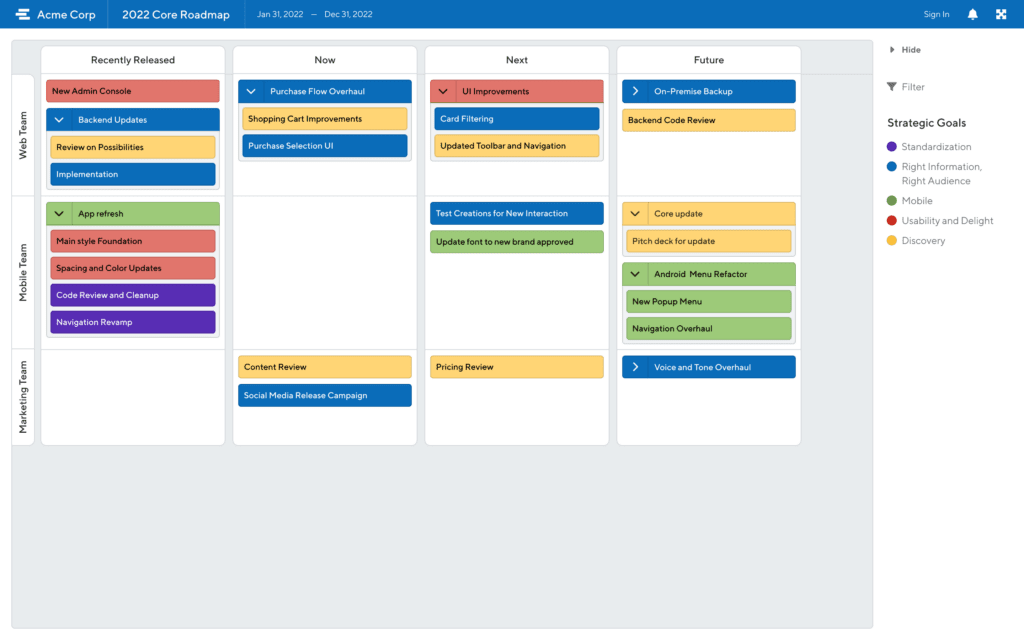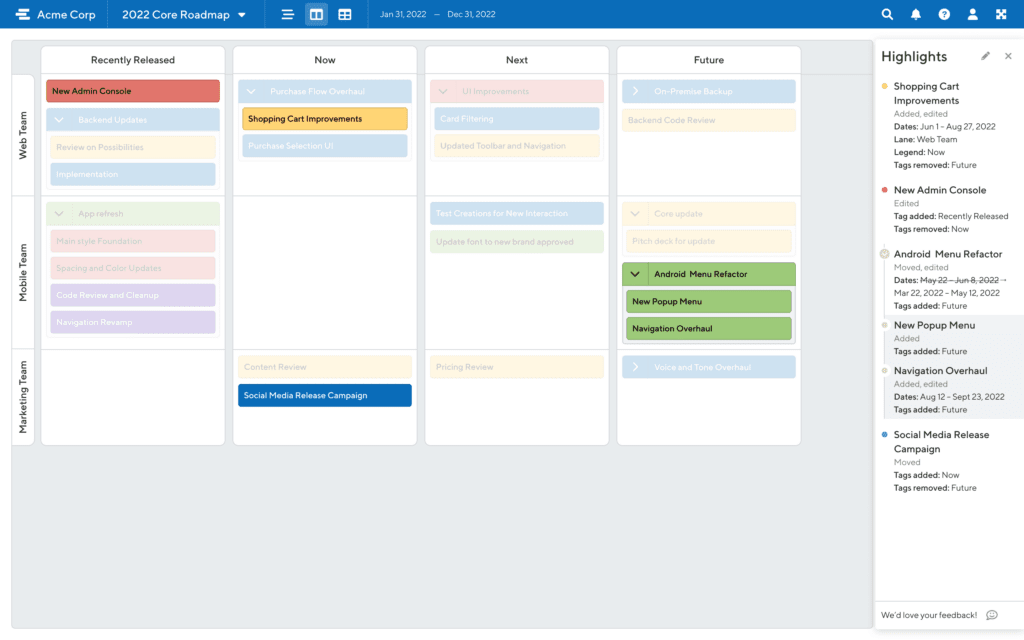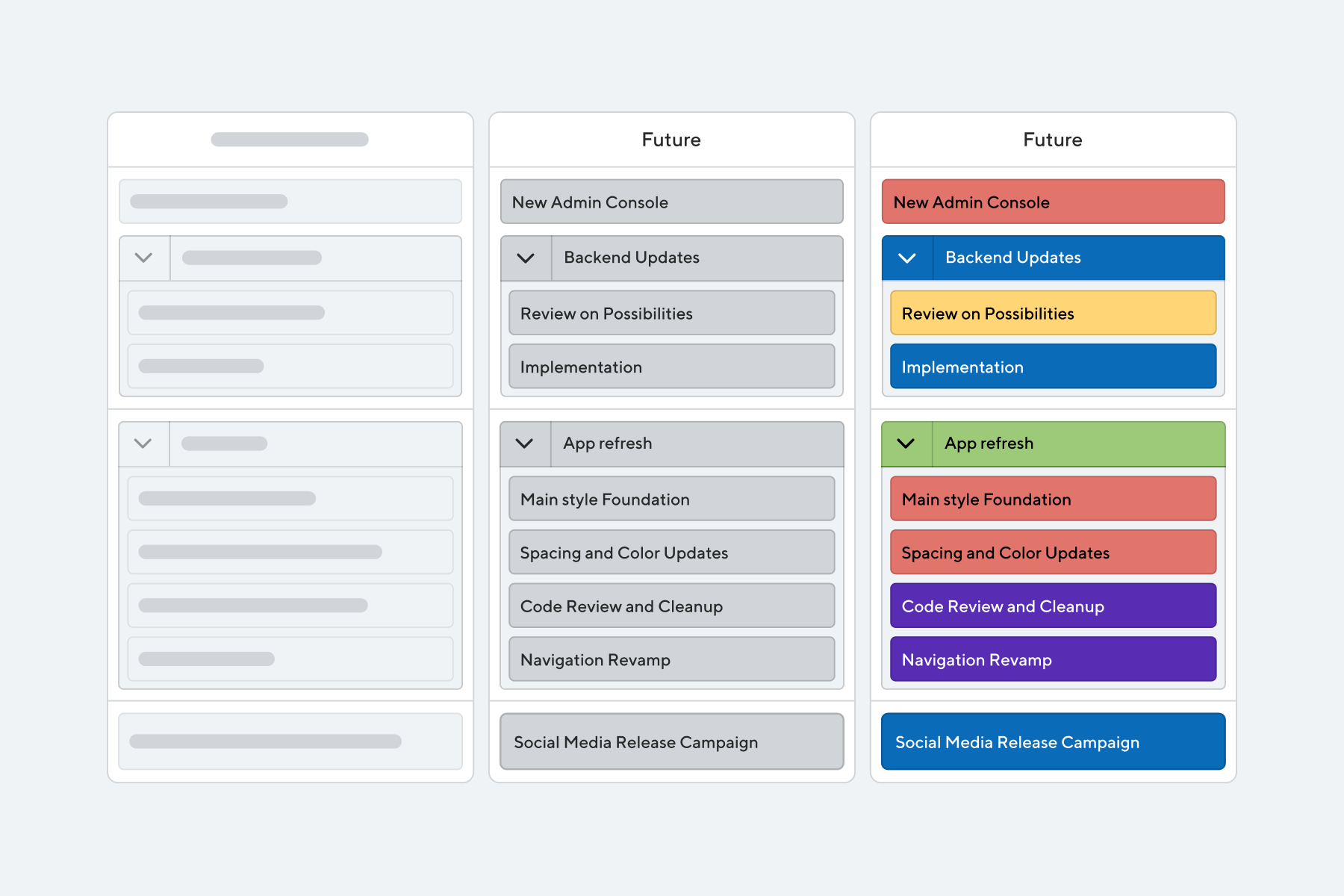At ProductPlan, we are revolutionizing how a company delivers products to market by elevating product organizations to the heart of strategy and execution. This vision holds true with our own organization as well. It is a very meta experience to build the ProductPlan platform as a go-to central hub for everything product management-related. As we help our customers overcome challenges, we’re using the same product we deliver to customers to overcome our own challenges. It’s a win-win situation!
This year, we focus on the major priorities that help us achieve our vision while maintaining an easy-to-use, delightful, and flexible user experience. Through this effort, we created a very exciting and strategic annual roadmap.
With so many impactful initiatives planned out for the year, we knew it was important to communicate with our customers and keep them updated on our product strategy. And what better way to do that than a customer-facing roadmap?
Why we built a customer-facing roadmap
Our customers are one of the major driving forces behind what we decide to build. Their thoughts and feedback are an incredible source of information for our product team. In fact, customer interviews play a key role in what gets prioritized and put on our roadmap.
The purpose of our customer-facing roadmap is to communicate the vision of ProductPlan and, at a high level, show the steps we’re taking in 2022 to realize our vision. And by creating a customer-facing roadmap, we can address common questions from our customers like:
- What is ProductPlan working on right now?
- What new features and updates are coming next?
- And most importantly, why is ProductPlan doing what they are doing?
Through this exercise, we have uncovered helpful best practices and tips for creating your own customer-facing roadmap. Keep reading to learn more!
How we built our customer-facing roadmap
When we began building our customer-facing roadmap, we thought about a frequently referenced metaphor for prioritization:
In this metaphor, you have a jar, rocks, pebbles, and sand. The goal is to fit the most important items into the jar. However, if you start with the sand and pebbles (the less important stuff), you quickly run out of room for the rocks. Instead, you start with the rocks, then the pebbles, and finally the sand. In that order, everything perfectly fits into the jar. The rocks leave gaps that the pebbles can fill, and the remaining gaps fill with sand.
So how does this translate to building a customer-facing roadmap?
We started with the rocks—these are the major items that we’re tackling to achieve our vision for the year. These are the product features that will have the greatest impact on our customers and therefore need to be on the customer-facing roadmap.
The smaller items (the pebbles and sand) typically don’t impact our entire customer base, and we don’t necessarily plan our development sprints around them. We can get more done when we properly prioritize these items according to importance.
The roadmap is designed to be dynamic and evolves over time. This can play out in a multitude of ways, but a great example is when we refined our filter functionality based on customer feedback. Thanks to the flexibility of our roadmap, we were able to accommodate this update.
Organizing major items on the roadmap
Once we decided on our “rocks” or major initiatives we planned for the year, our next focus was organizing this information into a roadmap that would make the most sense for our customers.
We organized four categories into columns from left to right on the roadmap to give our customers an insight into our plans. The four columns are:
- Recently released. The containers and bars in this column help our customers understand what problems we’ve recently solved.
- Now. Bars and containers in this column are problems we’ve committed to solving and are actively being built.
- Next. We’re currently researching bars and containers in this column and plan to build solutions for these problems next.
- Future. Bars and containers featured in this column represent items we recognize as an opportunity to invest in research but have not committed to building yet. The information here gives our customers insight into what we are thinking about long-term.
Below, is a mockup of what this kind of customer-facing roadmap can look like.

We also break down our product vision using bars, containers, and lanes:
- The Legend represents how we will execute our vision for the year. So everything featured in the customer-facing roadmap lines up to specific items in the legend.
- Lanes represent areas of investment. These areas are how we spend our time and help us ensure we can organize our resources towards our specific goals throughout the year.
- Containers organize bars and provide additional context.
- Bars feature details about specific features that contribute to the overall objective.
Our roadmap does not include everything we have planned for the year. It would be way too overwhelming if that were the case. So the smaller items, our pebbles and sand, don’t make it on the roadmap because they are lower priorities. Instead, we include them in our regularly scheduled release notes.
Take a look at the mock-up below to see how changes and updates to the container and bar details can be communicated in the Highlights section.

It’s important to note that we restart the roadmap each year, so we focus on the specific vision and goals that we set for that year.
How we share our roadmap
Our roadmap is a tool for starting a conversation with our customers. It is also an opportunity to learn more from our customers. Their feedback from conversations where we share the customer-facing roadmap helps us inform and refine our plan.
Our customer success team is trained on the ins and outs of our customer-facing roadmap so that we can have these important conversations at scale. With this training, our customer success team can speak confidently to the problems we are solving, they provide the product team with more insightful customer feedback, and it is a great way to develop deeper relationships with our customers.
As an added bonus, our roadmap also serves as a great training tool for our customers so they can build their own customer-facing roadmaps.
Looking to the future
We’re so excited about all of the major enhancements and updates planned for the year. Additionally, we’re looking forward to continuing our work with our customers to achieve our vision of revolutionizing product management.
